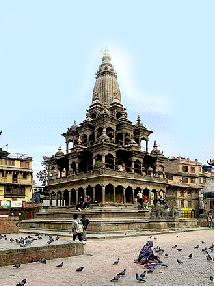Patan Durbar Square is also equally rich with heritage structures as that of Kathmandu and Bhaktapur Durbar Squares. This is also recognised by UNESCO as a world heritage site. Newar architecture is displayed with precision and purity in every building of this square. Krishna temple is the most important temple in Patan Durbar Square. A three-storied structure, it was built in the local variety of ‘Shikara’ style called ‘Granthakuta’.
The names of architectural parts, processes of repairs and restoration of heritage structures are slightly different in every part of the world. Typical Nepalese pagodas with serrated profiles standing on raised platforms stand out in the temples and other heritage structures of the whole of South and South East Asia. Diffusion and fusion of these features lead to the essence of style of the place. Interconnection with the neighbouring flairs is obvious and thus influence and connection with Bharatiya styles of temples is palpable.
The ‘Shikhara’ and ‘Nagara’ style of temples in Nepal evolved without the ancillary structures or ‘mandapas’. The medieval inscriptions and liberatory records have named the style as ‘Granthakuta’. The historical and cultural milieu has contributed to the architectural elegance so developed.
The Krishna temple was built in 1667 by King Siddhi Narsingh Malla. There are 21 golden pinnacles on the ‘Shikara’ of this three-storied temple. The first floor has the idol of Bhagwan Krishna with Radha and Rukmini on either side. The second floor is dedicated to Bhagwan Shiva and on the third floor is Lokeshwar. The cross currents of religions and life are depicted through every temple and are obvious in this Krishna temple as well. Krishna, the icon of many facets of life, is equally revered on this land. Open mind and aptitude for research may help us unfold every layer of the culture.














Comments